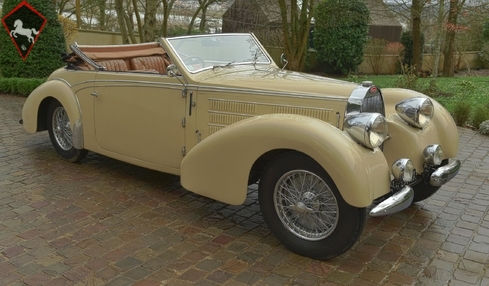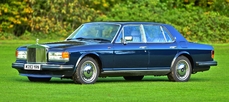Bugatti Typ 37 57C STELVIO CABRIOLET BY GANGLOFF 1939
Allgemeine Beschreibung :
1939 BUGATTI TYPE 57C STELVIO CABRIOLET BY GANGLOFF
*Highly original example*One of the last prewar Bugattis to leave the factory*Desirable supercharged version*Believed to have a mere 47.000 kms from new*An ideal open-top touring Bugatti
At the end of May 1939, G. Groslambert, owner of Garage Carnot in Besançon, ordered a drophead coupé Stelvio type 57C from the Bugatti factory. Chassis 57836/93C arrived at carrosserie Gangloff on June 8th 1939. The body was completed on July 24th for the sum of 30 000 francs. The drophead was delivered at Garage Carnot for Georges Groslambert, on July 28th 1939. The invoice amounted to 108.000 francs. No cars were delivered by the factory between July 8th and 28th 1939, for the obvious reason of summer holidays. This Bugatti Stelvio is one of the last two completed by Gangloff before the war was declared : 57834/103C and 57836/93C came out of the Colmar workshop in July 1939. It was the last Stelvio sold before the war. In May 1940 the last type 57C Gangloff drophead coupé, chassis 57805, was built and kept by the factory during the war.Georges Groslambert was the owner of Grand Garage Carnot , at 10-18 avenue Carnot in Besançon. He was a stockist agent for Bugatti and covered the Doubs, Jura and Haute-Saône departments.Georges Groslambert 1881-1958.This industrialist was born in Besançon on December 21st 1881 into a watchmaker's family. G. Groslambert first specialised in the production of tools, he owned « ateliers de constructions mécaniques » (workshop for mechanical constructions) at 23 rue de Vesoul, offering « machines spéciales et outillage de précision » (special machines and precision tools) under the commercial name « Précision ». The offices, shops and demonstration workshop were in Paris, at 61 avenue de la République. He also sold dynamos, coils... G . Groslambert's private home was his father's detached house in rue Nicolas Bruant in Besançon. It was soon equipped with centrally heated garages, workshop and gas pump to stock the personal cars of this car enthusiast industrialist. The first Bugatti bought by G. Groslambert was a type 44, delivered in 1930 by local Bugatti dealer of the time, Emile Perriollat. In August 1934 he acquired the all new type 57 Ventoux that he would keep for three years. At the same period, Groslambert took a new activity by taking a Bugatti agency dealing for the whole region. He based this new activity at « Grand Garage Central », 16 Avenue Carnot. A more modern garage was to be built at the same location in 1952. One of his two sons took over the activity as an Opel and Panhard dealership. From 1934 to 1939, no less than ten Bugatti type 57 were ordered by Garage Carnot, to meet the demand of industrialists and prominent citizens of the region. The last car, 'our' Gangloff blower drophead 57836, was ordered by G. Groslambert for his personal use. The car was registered at the address of the Parisian offices at 61 Avenue de la République, under plate number 7186 RM 7 in July 1939. During the war, according to family recollection, the car was supposedly hidden in one of G. Groslambert's factories, one of which in Saône-et-Loire at Épinac-les-Mines, was producing parachutes and gas masks. At the end of the conflict, our Besançon enthusiast entered his beautiful 57C in one of the first Rallye de Franche-Comté in September 1949. After G. Groslambert's passing, his widow sold the Bugatti to one of his friends and clients, Pierre Sironi. He was also a native of Besançon, born in 1912 and the owner of the company « Éts Croméclair-Pistolux » whose offices were in Paris, 16 rue Clovis-Hugues and factories at Noisy-le-Grand, rue du 26 août 1944. He specialised in pneumatic pistols, cellulose and synthetic varnish sprayers for cars, bikes, pieces of furniture, radiators.... P.Sironi prided himself on having painted the ocean liner France. He registered the 57C drophead at his Parisian office address, 16 rue Clovis-Hugues. The car was registered in the new registration system under Georges Groslambert's name at his address, 61 avenue de la République, with plate number 6431 FZ 75, on May 7th 1957. The change to Pierre Sironi's name on the carte grise is dated June 9th 1957. On a nice day in 1969, looking for a Delage D8S he could not find, young Alain Galopin, drove through a small village in the Oise department when he noticed through the open gate of a mansion... half the grille of a Bugatti 57 in a garage at the bottom of the park. He got in touch with the owner, M. Sironi, and the deal was sealed under the control of his wife who appeared to be in charge of the couple's finances. In 1977, the car entered finally A. Galopin's collection who entrusts its restoration to the Établissements André Lecoq in Saint-Ouen. The original ivory colour was found on some parts of the bodywork and the Bugatti repainted in its original livery. The mechanisms were serviced by M. Sochon, appointed mechanic of the restorer.When bought by A. Galopin the odometer read circa 30.000 km. It shows today a genuine 47.000 km! Three or four years after the sale, the Delage D8S of his dreams was offered to A. Galopin in exchange of his drophead 57C. He declined the offer having promised the vendor's family never to sell the car and also after having tested both vehicles on the road ! From 1978 on, the new owner used his proud drophead coupé regularly on few and rare chosen occasions. He was a faithful attendant at the Festivals Bugatti in Molsheim every year in September. The former race department chief mechanic Robert Aumaitre, he met at one of the Maurice Trintignant Jubilees in Carpentras in May 1982, was often his privileged passenger. He would give precious pieces of advice to the young Bugattiste... like the one suggesting to change to fourth gear as soon as possible over 60 km/h : « Take top gear, there's a blower ». Indeed the engine flexibility allows it and the engine would respond instantly with no lag time. The only fault with this method, was that consumption jumped to 24,5 litres. The two big 50 litres tanks were then very useful. On the highway, this grande routière finds its pace at 150-160 km/h then up to 180 km/h and shows modern cars that a Bugatti is still competitive. Lockheed brakes are very efficient to stop the drophead coupé weighing 1,700 kg. Let's not forget that the 57C engine is of the same type as the one which won the Le Mans 24 Hours, on June 17th 1939, which is also the birthday of Alain Galopin !Inspection of the vehicle confirms its history as a vehicle having been barely used :On the left side of the 57C dashboard, one finds a very rare Jaeger Chronoflight with a white background. It is visible on the photos taken at the time of the discovery of the car. Exclusivity of the brand, first reserved on airplanes, it became fashionable on most desirable sports car dashboards in the thirties, like Bugatti's Atlantic.The dashboard is of the six dial type 57C model.The tachymeter was never connected : The vendor's family states that Ettore Bugatti put it like that because G. Groslambert usually mistook km/h with rpm !Henri Novo unsuccessfully tried to convince A. Galopin to make it functional. So you have to drive by the sound... Numbers found on the vehicle :The original chassis plate is stamped 57836/ 19CV.The engine carries number 57836 / C 93.The blower, in accordance with the last types carries number 104. The total number of type 57C engines is 110 units.The front axle is engraved 93.The pig skin leather interior is completely original and in good condition.Brake and clutch pedals carry an EB logo... barely worn !The vehicle shows on each side, at the bottom of the doors, the Gangloff coachwork plate.As a conclusion :This drophead coupé, chassis number 57836, type 57C model exhibited at the October 1938 Paris Motorshow at the Grand Palais is the last sold by Bugatti at the eve of WWII.The workshop of coachbuilder Gangloff, rue Stanislas in Colmar, only delivered 40 type 57C chassis between 1937 and 1939, to make 4 seat Stelvio drophead coupé. Production of this model was exclusive and very limited as were all products of this Alsatian coachbuilder. Bodies are made according to different designs, of which this one is the most accomplished, the last model year 1939.The car has had only three owners from 1939 to 2017.The first owner only drove around 30 000 km, the war preventing further use one month after delivery and later the vehicle was only used on rare occasions by G. Groslambert until his death in 1957.Alain Galopin who owned the car for forty years, only added 15,000 km to the odometer.To this day, the car has not yet reached 50,000 km !This beautiful 57C drophead coupé looks as though it just left coachbuilder Gangloff's workshop. Its original ivory colour gives it a sleeker silhouette, thinner and lighter than most cars of the same period.It is one of the fastest thoroughbreds from Molsheim and one of the most desirable.
The current onwer is retiring having sold his business interests & thus wishes to pass the car to its next custodian. Viewings are by appointment to the west of Paris.
1939 Bugatti Typ 37 57C STELVIO CABRIOLET BY GANGLOFF is listed zu verkaufen on ClassicDigest in Essex by Prestige House for Preis nicht verfügbar.
Fakten der Auto
Karosserietyp : Auto Marke : Bugatti Modell : Typ 37 Ausführung : 57C STELVIO CABRIOLET BY GANGLOFF Hubraum : 0.0 Modelljahr : 1939 Karosstyp : Convertible Lage : Essex Fahrzeug Anmeldung : Undefiniert
Preis nicht verfügbar
Angaben Zum Verkäufer
Vintage & Prestige
Prestige House
+44(0)1375 379719, +44(0)7967 260673
Prestige House
+44(0)1375 379719, +44(0)7967 260673
People who viewed this Bugatti Typ 37 also viewed similar Bugatti listed at ClassicDigest
Other cars listed for sale by this dealer
über Bugatti
Ettore Bugatti, in Mailand geboren, in Molsheim Teil des Deutschen Reiches gründete das Automobilunternehmen, das seinen Namen im Jahr 1909 dann bis 1919.Bugatti wurde sowohl für den Detailgrad der Technik und für die ihre Jugendstil-Design bekannt.
Im Laufe der Jahre produzierte sie eine Reihe von Luxus-Autos, wie Bugatti Royale, sowie einige der berühmtesten Rennwagen. Bugatti Typ 35 ist wahrscheinlich der erfolgreichste Rennwagen aller Zeiten, mit mehr als 2.000 Positionen Essen.
Der Tod von Ettore Bugatti Sohn Jean Bugatti, während ein Typ 57 Tank-bodied Rennwagen testen, markiert einen Wendepunkt in die Geschicke des Unternehmens. Ettore Bugatti starb am 21. August 1947 Nach dem Tod von Ettore Bugatti im Jahr 1947 das Geschäft weiter rückläufig und Bugatti schließlich den Betrieb eingestellt im Jahr 1952.





















